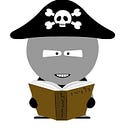Interviews with Children’s Writers
Jonathan Cott talks with Seuss, Sendak, Steig, Lindgren, Achebe, Travers, & Opie (from the Los Angeles Times Book Review)
The reader who expects softheadedness should be warned away. This is not a winsome foray into a saccharine world of childhood books and pleasant chats with their grandmotherly authors. Instead, this book is a serious, even profound study of complex writers and the depths concealed under the hard-wrought simplicity of their stories.
Somewhere near the end of this book, Peter Opie observes that the self-supporting, independent scholar is dying out. Jonathan Cott is proof that this figure is not yet extinct. It says something — both about Cott and the appeal of his subject — that portions of this book have appeared in such diverse publications as Rolling Stone and the New Yorker.
In Pipers at the Gates of Dawn, Cott discusses and interviews seven living children’s authors — some of whom are more often recognized by something other than their name: Theodore Geissel (Dr. Seuss), Maurice Sendak (Where the Wild Things Are), William Steig (Sylvester and the Magic Pebble), Astrid Lindgren (Pippi Longstocking), Chinua Achebe (perhaps Africa’s leading novelist), P.L. Travers (Mary Poppins) and Peter and Iona Opie (noted collectors of classic fairy tales and nursery rhymes).
The place to begin is the interview with Travers. How many people would imagine that the author of Mary Poppins was herself a part of the Celtic Twilight, close to poets William Butler Yeats and George Russell? How many can conceive that a steady diet of myth and folklore could produce such a remarkable woman, so warm and so acutely wise?
How many individuals–given the lack of seriousness with which children’s books and their authors are regarded–are prepared for Cott’s revelations? Seuss is a subversive genius. Sendak is a deep as Grimm. The neurotic torture of Steig’s New Yorker cartoons is unraveled in his children’s books. Lindgren thinks a sane maturity is paying attention to such fundaments of childhood as the house and the tree in the yard. Achebe believes that politics is often best discussed in children’s books. True folklorists, according to the Opies, would better spend their time on playgrounds — not in Borneo — where they can hear an underground tradition that keeps alive Sixteenth Century stories and even more ancient games.
Cott has done his research. He has approached each of these authors with the aim of being the most intelligent and sympathetic reader they have ever had. He takes a special pleasure even in anticipating their answers and their secrets, and more than once you can hear the muffled amazement of those he interviews: “How did you know that!”
Occasionally, there is the feeling that Cott has done too much research. His chapters are really a hybrid of the essay and the interview, and sometimes he smuggles into his interview a lengthy passage (of what would otherwise be intelligent analysis of the person in an essay) and then fashions it as a question: “How would you respond to that?”
Stylistically, Cott makes liberal use of parentheses. He has to. His mind is made quickly with associations. A conversation with Steig, for example, may lead him to an observations about Wilhelm Reich and then to observations about Chaplin, Stravinsky, Balanchine and Picasso.
The result is a density, a bramble the equivalent of ((( and ))), as Cott pursues an idea’s eclectic cousins. For some readers who prefer the straightforward path, this tour-de-force thicket may seem to need pruning. But for the reader willing to accompany Cott in his mazey ways, the book is a fertile abundance not seen since Norman O. Brown.
Wholly convinced by the subtitle of Cott’s book, I went right to the bookstore and set about rereading. I hope intelligent and open-minded readers will be similarly moved. Pipers at the Gates of Dawn should be put on the shelf next to another milestone book — Bruno Bettelheim’s study of fairy tales, The Uses of Enchantment— because it shows that childhoods are our common ground, lasting in their influences and as wide as they are deep.
This essay originally appeared in the Los Angeles Times Book Review (June 19, 1983). For a different take on Cott’s book, consider Perry Nodelman’s review in the journal “Children’s LIterature” (1985). Finally, I review Cott’s recent book on Maurice Sendak in the Washington Post:
If you liked this, “clap” below so others will see this on Medium. To see the ten most popular entries on this blog, click here. And if you’d like to read more essays like this, click the “follow” button at the top of this page.
Twitter: twitter.com/Jerry_Griswold
Facebook: www.facebook.com/griswold.jerry
